Imelda Staunton Finding Your Feet Interview
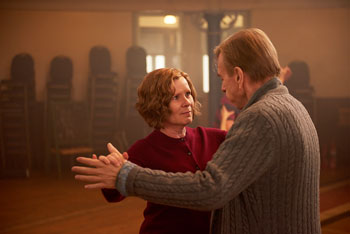
Born From Real Life
Cast: Timothy Spall, Joanna Lumley, Imelda Staunton, Celia Imrie, John Sessions, David Hayman
Director: Richard Loncraine
Genre: Comedy, Drama
Running Time: 111 minutes
Synopsis: When -Lady' Sandra Abbott (Staunton) discovers that her husband of forty years is having an affair, she seeks refuge in London with her estranged sister, Bif (Imrie). The two couldn't be more different. Sandra is a fish out of water next to her outspoken, bohemian sibling. But when Bif drags her along to a community dance class, Sandra's world is transformed. With unexpected friendships, romance, and a holiday in Rome on the horizon, Sandra begins to see an exciting new life for herself.
Featuring an acclaimed British cast led by Imelda Staunton, Celia Imrie, Timothy Spall and Joanna Lumley, Finding Your Feet is a hilarious and heart-warming comedy proving it's never too late to start again.
Finding Your Feet
Release Date: February 22nd, 2018
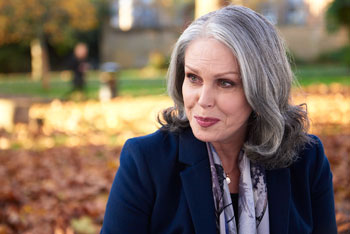 About The Production
About The Production
The moving and inspirational story behind Finding Your Feet was born from real life. Screenwriters and producers Nick Moorcroft and Meg Leonard were inspired by a theatre group in the UK to create a fictional story set around a seniors' dance class.
Nick Moorcroft and Meg Leonard sent their idea to producing partners John Sachs and Andrew Berg, who immediately saw its potential. 'The writers had the great idea of setting their story and their characters within this environment," notes John Sachs. 'I totally got it and I said, -Let's do it.'" Given the pan-generational popularity of shows like Strictly Come Dancing, the producers could see that the story would not only strike a chord with the grey-pound generation, but had the potential to reach out across all ages. 'It felt in the same vein as something like [The Best Exotic] Marigold Hotel," says Andrew Berg.
Fellow producer Charlotte Walls agrees. 'The story has a fantastic message for us all," she says. 'Its primary focus is on people of a certain age but its reach is far beyond that. It is about giving life a second chance and I think that message will chime with all audiences." The story certainly chimed with celebrated director Richard Loncraine, who had no hesitation in agreeing to take on the project. 'Films are mostly about script and casting," he says. 'It's like pyramids. The base is what keeps it stable. The actors will have agreed because they like the script, and I did it because I loved the script."
'But really it is a film about people and they're the best type of films. You really do care about these three people and you do fall in love with them. I think we have a film with real heart."
The three people are Sandra (Imelda Staunton), Charlie (Timothy Spall) and Bif (Celia Imrie) and it is the former who stands at the very heart of the story.
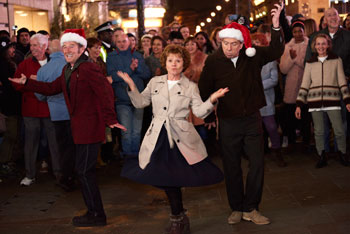 Characters & Cast
Characters & CastSandra is a rather uptight, very well-to-do member of the Surrey -tennis set'. She lives on a road lined with multi-million pound homes. 'She has raised a family and has been there for her husband throughout his career as a policeman, in which he has reached Commissioner status," explains Nick Moorcroft. 'She is the classic -woman behind the great man'," adds Meg Leonard.
Indeed, Sandra revels in the fact that her husband has recently been knighted, which is made apparent as the movie opens with a party to celebrate his retirement. Sandra has been planning their twilight years for the past three decades.
'That is where we started when we came upon the story," continues Meg Leonard. 'It's one of those stories where women lose their identity waiting to reinvent themselves, when they no longer need to support everyone else. That is where our film starts, on the eve of the retirement of her husband and what Sandra hopes will be the start of a new life that she has been planning for 35 years."
But then the rug is pulled from beneath her. 'She discovers that her best friend has been having an affair with her husband for the last five years," continues Nick Moorcroft, 'and suddenly the future she had imagined is taken away from her. And that leads to the challenge, the dramatic question for the character, which is: will she recreate and rediscover herself?" To play Sandra, the filmmakers turned to one of the most accomplished actresses working today; Imelda Staunton. 'In my opinion, Imelda is probably the most versatile and talented actress we have in the UK," says John Sachs.
'I'm just a huge fan. And her character needed everything – pathos, humour. It needed the whole body rhythm. We've dumped her in Hampstead Ponds, sent her dancing in Piccadilly Circus. She's done the lot."
Richard Loncraine, meanwhile, says that Imelda Staunton's skill is palpable, '…so much so that you don't really see the point where she changes from an unpleasant middle class snob to an accessible, kind and generous woman," he notes.
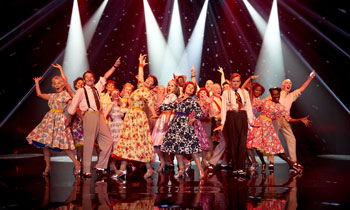 'I've watched our film many, many times now and you just don't see it. There's not a scene where it happens. Imelda Staunton is able to distribute that change of emotion and character over the whole movie, which is quite brilliant."
'I've watched our film many, many times now and you just don't see it. There's not a scene where it happens. Imelda Staunton is able to distribute that change of emotion and character over the whole movie, which is quite brilliant." Imelda Staunton says that she responded to the part immediately. 'It's nice to play a part where I'm my own age," she begins. 'And it's nice to see that people over a certain age do have a life; they do have heartbreak and they do have humour and they do have a future.
'We've got the richness of people who have had a life but who can also have a lot more happening in their lives as they go on."
With her life in turmoil, Sandra needs to get away from the horror of her predicament. But where will she turn? Her pride will not allow her to stay among her social set in Surrey. She must turn to her family, specifically her sister, Bif. The problem is that Bif is, on the surface, her polar opposite in every way. 'Sandra rather thrusts herself on her sister," notes Imelda Staunton. 'Sandra is a bit bossy, and there's plenty of bickering."
Bif certainly seems like the antithesis of her sister, notes Richard Loncraine. 'They have been estranged, having fallen out over a CND march many years ago," the director says. 'And much of the film is really about this sisterly love and how they find each other again."
Bif is very much a renegade, a maverick and something of a bon viveur. 'She doesn't give a damn about what other people think," says Meg Leonard, 'whereas Sandra's life has revolved around trying to keep up with the Joneses, gaining favour with the right people."
It is not easy for Bif, either. 'To begin with we see that they don't have a lot of respect for one another and they are very judgemental and intolerant at the outset," says Nick Moorcroft. 'And yet the sisters discover one another again, and they discover themselves through each other," adds Meg Leonard.
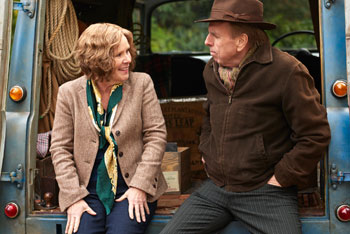 To bring Bif to life the filmmakers turned to celebrated stage and screen actress Celia Imrie, with whom Loncraine had worked on the Winston Churchill film The Gathering Storm. 'Celia was the first person I cast," the director says. 'She is just a wonderful actress."
To bring Bif to life the filmmakers turned to celebrated stage and screen actress Celia Imrie, with whom Loncraine had worked on the Winston Churchill film The Gathering Storm. 'Celia was the first person I cast," the director says. 'She is just a wonderful actress." For her part, Imrie loved the dynamic between the two sisters. 'They have led very separate lives," she notes. 'Sandra has lived quite a conventional life; Bif has not. When they're thrust together again it is not easy but it's wonderful when you have two sisters who seem very different but whom you discover are not that different after all."
Imrie and Staunton have known each other for many years, first working together on stage in Cabaret, as Kit Kat girls, back in 1978. 'It was lovely to work again with Imelda," says Imrie, 'and they're very interesting characters.
'I have three sisters myself and you can't forget those formative years; they'll always mould you," she continues. 'And in this story, being the eldest, Bif dares to push Sandra in a way she doesn't want to go. Also, you can be much ruder to a sister than you would be to a new friend because you've got all that past history!"
As she gets to grips with her new existence, Sandra meets her sister's friends, including her best mate Charlie, a pot-smoking antique furniture restorer, a jazz lover, who lives on a narrow boat in Maida Vale.
'There is a reason why he lives on the boat, having sold his house, which is a story that we reveal as the film goes on," explains Nick Moorcroft. 'It is something that is kept a secret from everybody, except Bif, who is his confidante and his closest friend within the dance class they attend."
Charlie has an ingrained cynicism. He sees the world out of necessity with a dry sense of humour. 'He is a colourful character but he is quite private," Leonard explains. 'We slowly learn about his back story. And his initial reaction to Sandra is that she is preposterous!"
But, very slowly, their relationship thaws, and eventually, starts to heat up in a different way, as romance blossoms. 'As in any classic romantic comedy," says Leonard, 'neither of them can imagine being together."
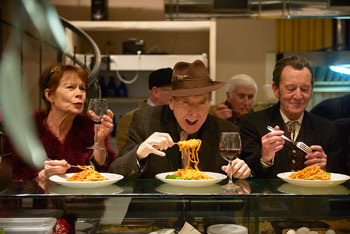 Opposites attract. 'And we had a lot of fun with that," says Moorcroft, who along with Leonard looked at the classic films in the genre – Adam's Rib, Bringing Up Baby, As Good As It Gets.
Opposites attract. 'And we had a lot of fun with that," says Moorcroft, who along with Leonard looked at the classic films in the genre – Adam's Rib, Bringing Up Baby, As Good As It Gets. 'You revel in the conflict and there is a lot of conflict," he continues. 'It takes a good hour before that relationship starts to form, where they recognise each other for the people that they are. Despite initially feeling as though they are opposites, they have in fact got a lot in common."
For the role of Charlie, the filmmakers cast much-loved actor Timothy Spall. In fact, it was Loncraine who gave Spall his big break, casting him in his first film, the 1980 teleplay The Vanishing Army, just after he'd left Rada. Finding Your Feet is their fourth project together.
'Tim Spall is just a legend," says Berg, 'and as soon as we knew he liked the script, we knew we had our trio."
Spall not only liked the story, but was also happy to play someone he regarded as fairly close to home. 'Having just played the Reverend Ian Paisley [in The Journey] and David Irving [the Holocaust denier in Denial], to play someone of my age who looks a bit like me, talks a bit like me and dresses a bit like me was rather nice," he laughs.
As regards Charlie's relationship with Sandra, he enjoyed that immensely. 'Immediately, they don't get on at all," he says. 'Sandra is really not sure about Charlie because he's scruffy."
They first meet when he is fixing up Bif's flat. 'Then she meets him when he's stoned and doing slightly eccentric things. And when he makes the mistake of giving her advice, she takes umbrage with that."
Alongside Bif, Charlie's other best mate is his narrow boat neighbour Ted, played by David Hayman. 'Ted is an enigma, a Teddy Boy, an aging rocker," says the actor. 'His heyday would have been the '50s or the '60s. He is very lonely, having lost his wife within the last year.
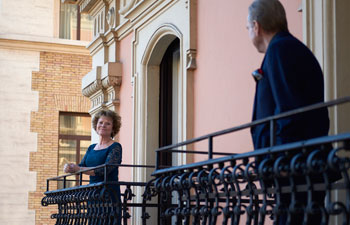 'He and Charlie get together on their house boats, smoke a lot of dope and refuse to accept that the fading of the light is coming!"
'He and Charlie get together on their house boats, smoke a lot of dope and refuse to accept that the fading of the light is coming!" Like Bif and Charlie, Ted is also a member of a seniors' dance class " as is the memorable supporting character Jackie, played by Joanna Lumley. 'Jackie was a professional barrister and was very good at doing divorces," says Lumley of her role. 'She has quite a bit of money, has been married five times, so is maybe not the easiest person to live with but is very feisty and she loves belonging to this dance club."
The other notable member of the dance club is the instructor, Corrinna, played by Indra Ové. 'She loves teaching the over-50s," says the actress of her character, 'and she gets very involved. It was really interesting because while I was learning the dances with the rest of the cast, I also had to watch the choreographers to see how they teach! It was great fun."
The Dance Class & The Dancers
The dance class, and the recitals that the group put on, are integral to Finding Your Feet. And though director Richard Loncraine had incorporated dance into the commercials he had made earlier in his career, he'd never worked with so many set pieces. 'The dance was my biggest fear in the whole movie," he says. 'There is a lot of it!"
One of the key considerations was the level at which the actors should perform. 'First of all, the main cast and the people they play are not professional dancers," continues the director. 'They had to be good but they couldn't have been so good that it would seem ridiculous." It was, he says, a fine balance. 'They had to be better than most people would really be because you don't want to go to the cinema and see real life. You want to see something slightly bigger than real life."
Another important consideration was that the dance should be integral to the main story, and not a sideshow. Hence, for Sandra, attending her sister's dance class not only drags her out of her comfort zone but it brings her into contact with new people, too.
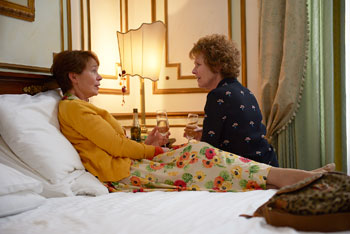 'For Sandra, the dance allows her to be freer and it allows her to unlock things that she's kept locked away for many, many years," says Staunton. 'You find women and men who are trapped in bad marriages and don't realise that they are in a bad habit.
'For Sandra, the dance allows her to be freer and it allows her to unlock things that she's kept locked away for many, many years," says Staunton. 'You find women and men who are trapped in bad marriages and don't realise that they are in a bad habit. 'I think a lot of women sacrifice many things to keep their marriage and to keep their partner, allowing their lives to be the stronger element and my character has done that. To get the release from that and be exposed to her sister, who is so free and easy is wonderful, and the dancing gives Sandra a real chance to find liberation."
The dance class also opens the door to a new romance. 'It is when Charlie and Sandra first dance together that a real connection is made," says Spall. 'You think you know what sort of people go to a dance group but this film introduces you to a tapestry of experience, and you see how layered these characters are.
'This thing all these people do together is a fulcrum; it's where they meet," he adds. 'They take it seriously enough to want to get it right. It's like a self-help group."
Indeed, for all the characters that the audience meets, the dance group acts as a balm for their troubles. 'It's like a drug in itself," says Spall. 'It's a social thing, a hobby with these benefits.
'And there is something very sincere about it, a mixture of skill and charm. Sometimes, I felt very touched watching the dancing; seeing all these individual triumphs and sorrows and break ups – this mass of experience at this age, when you're no longer regarded as interesting any more.
'We are being shown this massive tapestry of life that's going on beneath this dance. It's not po-faced, there is humour in it, but there's also a real sincerity."
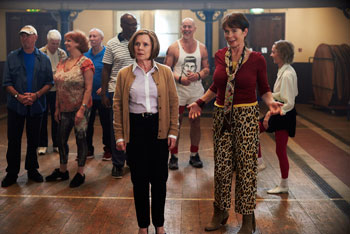 Imedla Staunton agrees. 'These people going to a dance class isn't just funny; it's also quite moving," she says. 'It's not how good their dancing is! It's about people not being isolated. 'Being part of a group is really important. We are living longer. These people are feisty. They have got fight and they have got hope and I find all those things rather appealing. The dancing in this film is a metaphor for all our inner feelings."
Imedla Staunton agrees. 'These people going to a dance class isn't just funny; it's also quite moving," she says. 'It's not how good their dancing is! It's about people not being isolated. 'Being part of a group is really important. We are living longer. These people are feisty. They have got fight and they have got hope and I find all those things rather appealing. The dancing in this film is a metaphor for all our inner feelings." Joanna Lumley says that she loves the emphasis on older people dancing. 'It's holding people and dancing with people, getting old people to get up and move. In fact, I think dancing should be compulsory in school!
'The film celebrates friendship and optimism," she adds. 'These people who join clubs and get on with each other have a laugh. Plus, they do dances that you wouldn't expect people of 60 or 70 to do."
The group was asked to tackle dances as varied as a Viennese waltz, jive, disco and salsa. There's even a movement inspired by the -nutty boys' themselves, ska icons Madness. 'It's a varied pizza of dance," smiles Spall. 'Definitely, it's not a Marguerita. It's a full Hawaiian with plenty of extras!"
Ashley Wallen, the Australian choreographer, put the dancing set pieces in the film together. He has worked with stars such as the Sugababes, Kylie Minogue, Will Young, Robbie Williams and Mariah Carey,
'Ashley assessed the actors' capabilities and how much time they'd need in rehearsals," says producer Andrew Berg. 'They were all pretty good to start off with; Celia, Imelda and Joanna were brilliant to begin with. Often it was just a confidence thing."
Assistant choreographer Mark Jennings handled the day-to-day work. 'It's not just typical ballroom dancing," he insists. 'At one stage we have the guys doing the robot and hip-hop movies. It's an A-Z of dance that they go through.
'I think audiences will be slightly shocked and amazed at the standard. The actors really went for it in a big way. You really want to join in!"
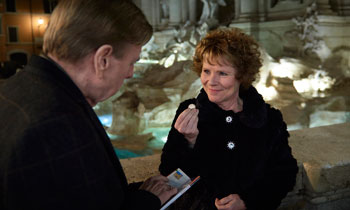 To supplement the three main cast and the supporting actors, the class is rounded out with 15 former professional dancers.
To supplement the three main cast and the supporting actors, the class is rounded out with 15 former professional dancers. Richard Loncraine explains, 'We had 20 people in the troupe – five cast and 15 former professional dancers, who had been in things like A Chorus Line and Hair."
Jennings adds, 'Dancers often think everything is over by 35, but some of our guys are 66 and they're going for it! It's brought them a new lease of life." The camaraderie between the ensemble dancers and the principles was palpable, he says. 'Everyone was equal."
Indeed, Imelda Staunton has known some of the professional dancers for years. 'When I played Dorothy in the Wizard of Oz at the RSC in 1986, one of the guys was in that," she remembers. 'It felt very comfortable and we were all in it together."
Imrie says that watching the former professionals getting to work on the dance-floor once again was both invigorating and moving. 'I was really touched to see the gentlemen dancing because they are of an age," she recalls.
'It's quite clear from the way that they swish around the floor that they have danced all their lives. Now, they're being given a chance to do it all again and there is something incredibly moving about seeing them giving it everything.
'The women are wonderful, too, but there is something quite unusual about seeing the chorus boys, as they were, so many years on."
The former professionals who comprise the dance class were all thrilled to take part. Over 150 dancers turned up for auditions and those that made the final cut include the likes of Basil Patten, a veteran of Oliver and Fiddler on the Roof. He is 74 years old. 'Being in this film at this stage of my career has been truly wonderful," he beams.
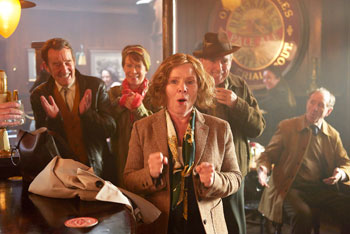 At just one year his junior is Christopher Malloy, 73, who echoes Patten's sentiments. 'I've been in many, many shows but I'm particularly excited about this as it's come at such a late time in my career," he says.
At just one year his junior is Christopher Malloy, 73, who echoes Patten's sentiments. 'I've been in many, many shows but I'm particularly excited about this as it's come at such a late time in my career," he says. The dancers' on-screen exuberance, however, comes at a price. 'I've been retired for a while," says Christina Avery, 67. 'I've had the best time – it's been like a holiday – but it has meant painful joints, especially in my back, neck and feet."
Her feet ache most of all. 'I've got sore balls as we say in the trade," she laughs.
All the dancers have enjoyed careers on screen and stage and Fred Folks, for one, was on Britain's Got Talent as part of a group called Old Men Grooving. He recently did Children in Need.
As for the main cast, they all revelled in the chance to strut their stuff. 'Actors can feel a little vulnerable when they're dancing," notes Jennings, 'but this cast really took it on and went for it."
For Imelda Staunton and Imrie, who were chorus girls in their youth, the dance sequences were a joy. 'I am a chorus girl myself," smiles the latter. 'I began in pantomime and dancing is a great love of mine."
Imelda Staunton, however, who recently excelled on stage in the hit musical Gypsy in London's West End, admits that for all her experience, the dancing was far from easy. 'It has been painful because even though I've done musicals, I have not done huge dance scenes in them," she says.
'That said, when you struggle together it helps with the bonding. This is a job and it's hard work!"
Timothy Spall echoes those sentiments. 'The moment you have some down-time someone's grabbing you to make you do a soft shoe shuffle or some other dance," he says. 'In fact, the only time you get a rest is when you're acting!"
Hayman notes that he hadn't danced since he last did pantomime 25 years ago. 'I used to say to my wife that I wish they'd ask me on Strictly Come Dancing but now, having been through this process, I would never go on Strictly," he laughs.
'It must be really punishing. Just what we've been through to get the dance routines correct – and they don't have to be perfect – is a lot of hard work.
'One of the really terrifying things was that we all had to dance in Piccadilly Circus on an evening," he adds. 'We do a mash-up of all the dance styles; 20 of us dancing with all the tourists and Londoners and hidden cameras."
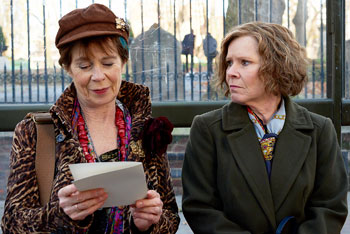 Dancing On Location; Shooting On Location
Dancing On Location; Shooting On LocationThe dance sequence in Piccadilly Circus is one of the film's most memorable set-pieces. It involves a flash-mob of the entire dance troupe and it was filmed one Sunday evening, in winter the middle of one of London's busiest tourist areas.
In the story, the dance group heads out to raise money for AGE UK and their Spread the Warmth campaign. 'The Age UK tie-in is very relevant. Life is for living and there is no age limit on that," says Berg.
Originally, the dance sequence was set on a railway station but when this proved impractical the filmmakers tried the South Bank and then, taking the bull by the horns, Piccadilly Circus. 'The Piccadilly scene is very ambitious," continues Berg. 'It had to be something in the story that could go out wide- become viral and get the dance class invited to a big dance festival in Europe.
'And, of course, Piccadilly is iconic. Kudos to our locations team because that was not an easy thing to pull off."
The scene was filmed with the 20-strong dance class, 50 extras and 600 real onlookers. Richard Loncraine used a selection of cameras that were very lightweight and he shot the scene five times over the course of two hours. The filmmakers had luck on their side because it didn't start to rain until they had four takes in the can!
The Piccadilly Circus dance sequence then sees the dance class invited to perform at a dance festival in Rome.
'The Rome dance is more formal than what we see in Piccadilly Circus," says Richard Loncraine, who needed to focus on two approaches to the overseas set piece.
'First we need to see the dance scene from the perspective of the audience. There's a proscenium arch so I didn't want shots in funny places because that's not what an audience would see." This part of the dance sequence was therefore classically shot from the audience's perspective. 'But, at the same time there's a story with Bif, where she must dance, and there I was on stage, using handheld cameras."
Richard Loncraine says that he tried to get everything choreographed in one shot, '…so I can jump from one master shot to another. You get a much more interesting photographic look to the film; it has much more style.
 'It's what they do in great movies like Who's Afraid of Virginia Wolf? You don't see the photography. I've been criticised in my movies with people saying there's no direction. Well, that's a compliment. I don't want to see direction. I don't like directors who show off. 'With the actors I had, it was like having amazing gymnasts. I didn't want to be on stage, hand-holding."
'It's what they do in great movies like Who's Afraid of Virginia Wolf? You don't see the photography. I've been criticised in my movies with people saying there's no direction. Well, that's a compliment. I don't want to see direction. I don't like directors who show off. 'With the actors I had, it was like having amazing gymnasts. I didn't want to be on stage, hand-holding." Other key locations for Loncraine and his cast and crew include Hampstead Ponds, one of Bif's favourite haunts. At one point, she persuades Sandra to try a dip.
Another is the Soho district in London. The latter, says the director, involved 'quite a lot of guerrilla filming."
'We had scenes of Imelda Staunton and Tim Spall walking around Soho at Xmas. Normally, you control the street and have extras and lighting, but with the modern cameras working at low light levels, we could get away with a really natural feel."
The natural feel should add to the quality of the film. 'I think this film is unique," concludes Imedla Staunton. It's not like anything else. We're playing middle-aged people who are trying to reclaim the rest of their lives. They have all been disappointed along the way, but all the characters are now trying to have a future.
Timonthy Spall agrees, adding, 'The film has dance at its centre and it is what these people do as an aide. But it's not something they go on about. The story is about people of a certain age just getting on with and living in one of the world's great cities. I'm sure people will respond to that."
Finding Your Feet
Release Date: February 22nd, 2018
MORE
- Mission: Impossible Fallout
- Glenn Close The Wife
- Allison Chhorn Stanley's Mouth Interview
- Benicio Del Toro Sicario: Day of the Soldado
- Dame Judi Dench Tea With The Dames
- Sandra Bullock Ocean's 8
- Chris Pratt Jurassic World: Fallen Kingdom
- Claudia Sangiorgi Dalimore and Michelle Grace...
- Rachel McAdams Disobedience Interview
- Sebastián Lelio and Alessandro Nivola...
- Perri Cummings Trench Interview



